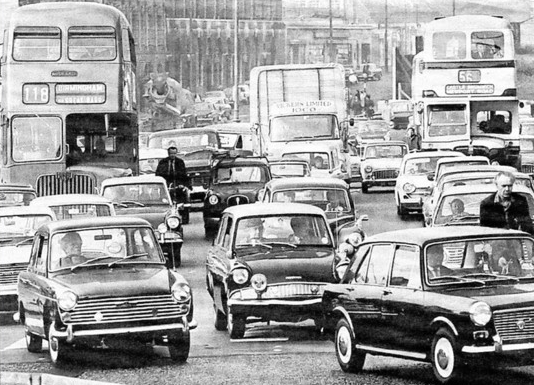Alan Clawley looks at an eternal problem.
To state the obvious, our towns and cities were not designed for motor vehicles. Yet despite understanding this hard fact the users of motor vehicles still insist on exercising their freedom to drive in unlimited numbers in cities and park as near as possible to where they want to end up. Measures to mitigate the worst effects of the use of motor vehicles, such as parking meters, speed limits and congestion zones, are accepted grudgingly and viewed as a gross limitation of the motorists’ freedom. Only new roads and parking places are welcomed as a way of spending public money.
Yet we have seen in Birmingham that huge and costly efforts made by the planners to physically accommodate the motor car during the 1960s and 1970s have not been successful. The Inner Ring Road that was intended to relieve the city centre of traffic has since been called a ‘concrete collar’ and part of it removed, a clear admission of its failure to relieve the problem of traffic congestion.
Professor Colin Buchanan predicted the failure of ring roads in his book Traffic in Towns as early as 1963. As Professor of Transport at Imperial College of Science and Technology in London he was appointed by the Minister of Transport, Ernest Marples in 1960 to make a study of the long-term development of motor traffic in urban areas and the effect that it was likely to have on the cities of Britain. He looked at how towns and cities could be adapted to maximum car use as well as commenting on the solutions, such as Ring Roads, already being tried out.
He wrote: “The principle of the ‘relief road’, embodied in a proliferation of proposals for ring roads in towns all over the country, was an intuitive concept rooted neither in understanding of the realities of traffic generation and flow, nor in any quantitative idea of ‘relief’. It is possible that the appropriate network pattern for some town might take the form which could be described geometrically as a ring, but it does not follow that a ring is a suitable prototype for every town.
“Many of the post-war plans demonstrate the peculiar difficulties of the inner ring road, its rigid encompassment of the centre, severance of the central area from the rest of the town, frequency of major intersections on a comparatively short length of road, encouragement of traffic along old-type radial roads, and the problem of constructing it through densely developed property.”
Buchanan’s comments are very prescient in the light of Birmingham’s own ring road history. If the city engineers ever read the book they clearly chose to ignore its author’s advice. The report did however inspire planners and architects to try out radical solutions such as ‘vertical segregation’ as part of the comprehensive redevelopment of large parts of our major cities that had not been ‘spoiled’ by piecemeal commercial development. Paradise Circus is Birmingham’s prime example of Buchanan in action. But even that bold initiative has since been declared a failure by the city council.
Faith in road solutions has recently re-surfaced with the City’s grandiose plans for a Philadelphia-style urban motorway underneath the city centre. No traffic studies have been published to support the proposal and it is probable that, like the inner ring road, it would prove to be a catastrophic and expensive mistake.
Buchanan saw that there was a finite and calculable number of vehicles that any city street could accommodate above which environmental conditions became intolerable. When the capacity of the street was exceeded, as it was in Birmingham’s New Street, everyone suffers. The solution was not to widen the street but to close it to the traffic and hand it over to pedestrians.
This lesson doesn’t seem to have been learnt on a wider scale. The city centre is a collection of streets, each with a finite capacity for vehicles. Add the figures up for all the streets and you have the total number of vehicles that the city centre can handle without undue stress. The ingress of cars can be controlled physically, by closing streets, reducing the number of parking spaces or charging them to drive into the centre.
Limitations on motor car use are unpopular at first, but when people see the benefits – quieter pedestrian streets with market stalls, safer cycling, cleaner air – they accept them and change their behaviour. Using a car for a city journey will become the least sensible option and even the value of owning one will be questionable. For a city that made its living making cars, this is hard to swallow;
Birmingham will take longer than Norwich or London to get over its love affair with the car. In the meantime our city planners will go on making and undoing their expensive mistakes.
